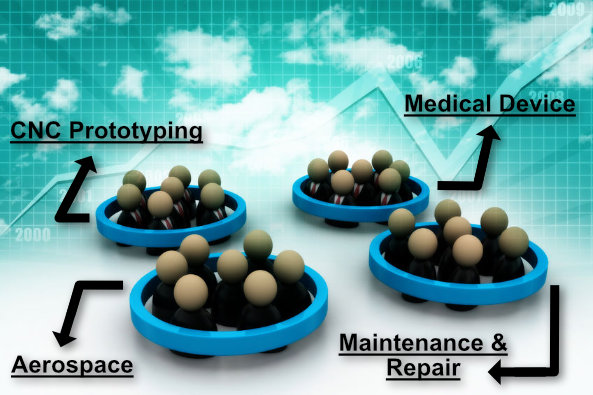Did you vow to acquire a manufacturing business in 2017 but were unsuccessful? Here’s how you can make 2018 YOUR year. We all know success takes planning, strategy and action. It’s equally important to make sure that your efforts are aimed in the right direction. The most common buyer of small manufacturing businesses in today’s market are individual buyers, usually leaving corporate America to build something of their own. Although this article is aimed at that group, it is equally relevant for private equity groups who are struggling to find appropriate buys.
Follow These Basic Rules to Successfully Acquire a Manufacturing Business in 2018
Background – What Most Buyers Want:
We get dozens of inquiries each month from buyers trying to find the perfect manufacturing business. Beyond specific geographic criteria that most have, there is commonality in what they seek including:
- Recurring Income
- EBITDA More Than $1 Million
- Product Based
- Sales In An Upward Trajectory
- Operating And Manufacturing Systems In Place
- Customer & Sector Diversification
- High Gross Margins
- Low Hanging Fruit For Increasing Production & Sales
Of course there are other criteria, but these are the most common that we see. The purpose of this article is to show you how you might be able to get everything you want by looking in a different place…. or should I say looking for a different size. Take heed of the following rules to successfully acquire a manufacturing business in 2018.
Acquisition Success Rule #1:
Expand Your Search Criteria
According to the U.S. Census Bureau, there are 251,901 firms in the manufacturing sector, with all but 3,749 firms considered to be small. How small are they? Better than three-quarters of these firms have fewer than 20 employees.
If you want to get an education on the limited number of larger manufacturers in the U.S., call a mailing list company and ask for only those manufacturing companies with revenues over $5 million. What you’ll discover is that the list is small. So the #1 Success Rule is to expand your search criteria, by looking at slightly smaller companies.
Before you object, thinking that smaller means a lack of quality, you should probably read further – that is unless you want to be in the same boat at the end of 2018. Even the private equities with more stringent acquisition criteria than listed above are starting to expand their criteria to include smaller companies.
The why of that is simple – there is simply an insane amount of competition for companies with EBITDA in excess of $2 million. As I indicated above, private equities are looking at deals slightly lower than $1 million in EBITDA, provided certain other criteria is in place.


Acquisition Success Rule #2:
Small Doesn’t Mean Poorly Run
I’m about to start my 25th year of selling manufacturing businesses. That, combined with the fact that I speak to hundreds of quality buyers each year from all over the country, gives me unique insight into small manufacturing companies and how most buyers perceive small. Most would include the following in their perception of small manufacturing companies:
- Lack of operational systems in place
- Lack of lean manufacturing procedures
- The business is completely dependent on the owner
- Transition will be a nightmare
The truth is there is a wealth of very well run smaller manufacturing companies with EBITDA between $600,000 to $1 million. Smaller than most buyers want for sure, but most have the ability to quickly reach the magic million mark in a short period of time.
To give you an idea of a small but incredibly well-run company, consider a Southeast specialty tooling, prototype and EDM shop for sale, (cash flow $627K). This business has organization better than most companies five times their size. The plant is modern and pristine, (like eat off the floors pristine). They have long-term relationships with customers, name recognition and little geographic competition in the tolerances and capacities they work to. But here’s the thing… they don’t market themselves. Which leads us to Rule #3.
Acquisition Success Rule #3:
Small Companies Usually Have Low Hanging Fruit For Scale Up Opportunity
This is so very simple and basic, but so often overlooked in manufacturing M&A by buyers looking to Acquire a Manufacturing Business. The people seeking acquisition are usually younger than those selling and much more tech and social savvy.
If the guy with silver hair retiring from manufacturing is netting $600K to $1 million with a website that has not been updated since Bill Clinton was in office, (stop laughing…. I’ve actually seen this) or better yet, no website at all and NO marketing or social media engagement, what can you do with the same business? Some of these guys approaching retirement are on auto-pilot. They’re making incredible margins (in the case of the company I described above, gross margins are more than 70%), with little or no effort. Some of these companies can experience substantial increases in sales with a new owner instituting very inexpensive things like:
- Website Update With Online Quoting Mechanism
- Establishing A Presence On Social Channels
- Explaining Full Capabilities To Existing Customers
- Making Sales Pro-Active Rather Than Reactive
The chances of doubling sales and cash flow in a small company like this are oftentimes exponentially better and faster than with a company that is already doing the above.


Acquisition Success Rule #4:
Look Deeper Than The Basic Percentages On Customer & Sector Concentration
Everyone wants an acquisition with little sector or customer concentration; but is there always danger in concentration? Consider a small manufacturer who has a customer relationship spanning over 5 decades. The customer is an industry powerhouse and a name recognized to any business person. The manufacturer provides prototype and small runs, which become part of mission critical equipment. Their gross margins are in excess of 60%. Their customer relationships have survived several regime changes including large mergers in the customer’s organizations.
The fact the customer relationships are strong, can’t be argued. However, most acquirers would bypass this at a 48% customer concentration. But is there more to the story if you dig deeper? This particular company can’t do the large production runs of the parts they’ve prototyped because they aren’t ISO certified. They could easily apply for this and easily get the increased work. With the shareholders at retirement age, living a debt-free lifestyle on 60+ percent gross margins, they simply don’t want to put forth the effort. Digging a little deeper is sometimes key to finding that needle-in-a-haystack good deal.
Acquisition Success Rule #5:
Engage Industry Experts To Help In Your Search
It can be a full-time job to sift through the garbage acquisitions that are out there. I met with a buyer today who has requested tax returns from a broker on a listing with another brokerage house without response for 2 months. It’s a jungle out there and you should enlist help from people who specialize in Manufacturing M&A. Choose to work with specialists who only take quality listings and already have all the information they know you’ll need to successfully make it through deal financing and underwriting.
If you want to successfully acquire a manufacturing business, get on the listing alert lists of a specialist in the industry. Schedule a call with the brokers to introduce yourself and explain why you’re a good candidate. Many brokers will give a head start to potential buyers on new listings when they know the buyer is the right fit. If you’re introducing yourself to an organization, consider providing the following information so they know you’re for real:
- Your professional background
- Your time frame for making an acquisition
- The speed with which you have the ability to move
- Your pre-qualification if an acquisition loan is required
Often buyers are reluctant to share basic information. Here’s what you need to know. Brokers with quality manufacturing listings are bombarded weekly with buyers seeking a first look at their listings. If you want to win, you must be forthcoming with information and make yourself stand out. If the broker or M&A intermediary really understand that you’re a quality buyer, they’ll do everything they can to help you.

Accelerated Manufacturing Brokers
Follow these 5 Acquisition Success Rules and you’ll dramatically increase your chances to successfully acquire a manufacturing business in 2018. Or said differently… size matters, but not in the way you think! Best wishes in your quest to successfully acquire a manufacturing business. Contact us if you need direction or fill out our buyer form to help us understand your criteria.

